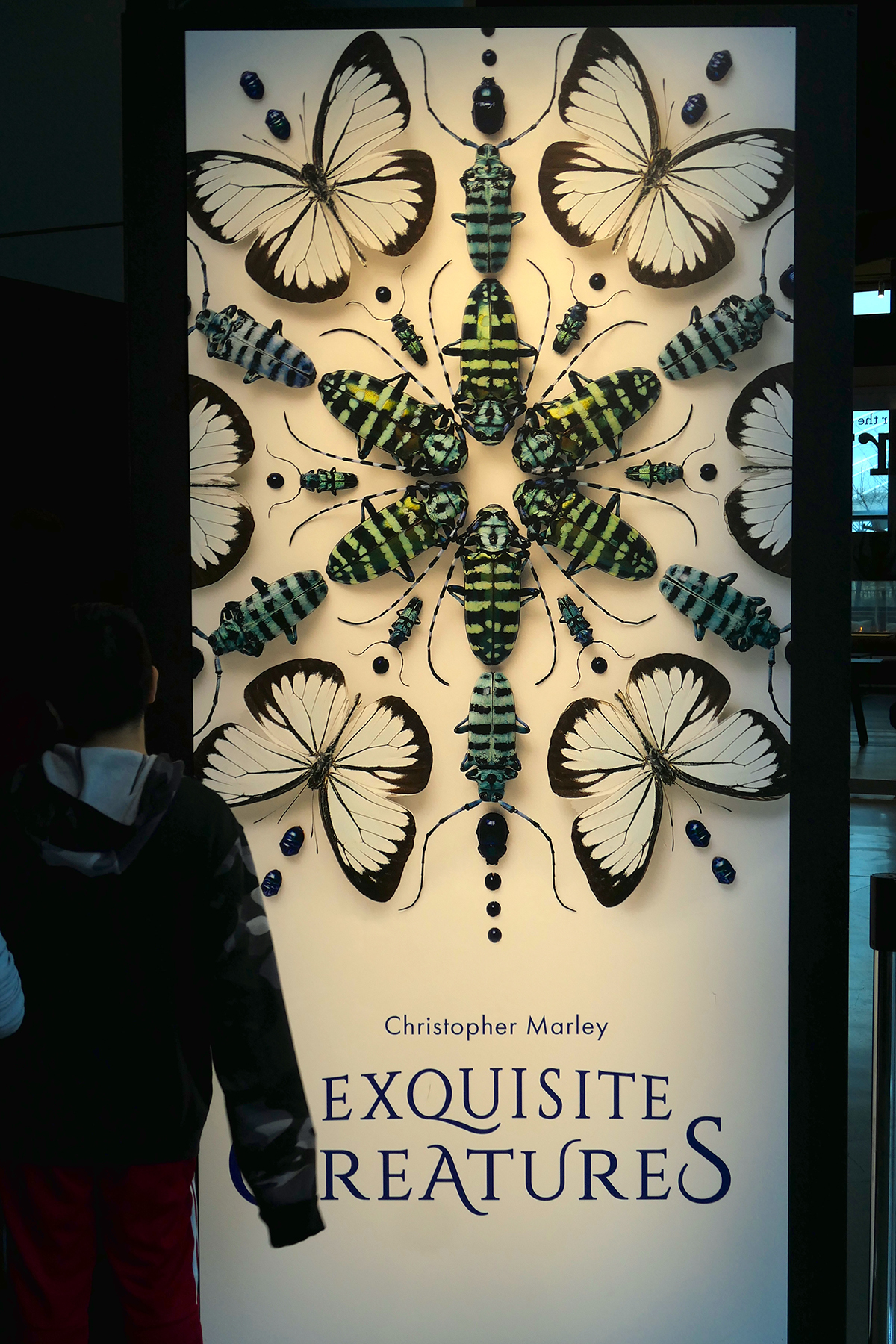If you enjoy perpetual whiplash between disgust and fascination, do I have the thing for you! That is, if you hurry – this is the last weekend of Christopher Marley’s Exquisite Creatures at OMSI, and then they are packed away in cartons, glass or metal containers, and shipped off.
You’ll meet a jarring abundance of dead animals, 1000s and 1000s of them across two full floors of the museum, with the amounts of applied embalming fluid alone making centuries of Egyptian pharaohs roll in their pyramids, green with envy.

The exhibition shows the corporeal remnants of insects, butterflies, chameleons, crabs, scorpions, shells, snakes, turtles, fish and birds – all found dead, it is repeatedly emphasized, not killed for the show. The point, though, is, they are mostly not displayed as single specimens, to introduce the public to the wonders of nature, as they would in a natural history museum, where the aurochs might elicit awe that cannot be had on the streets of NYC (or only be had by other sources…)

The corpses are displayed in patterns and arranged by color, carefully calibrated by Marley, a self-taught naturalist who was a school drop-out and men’s fashion model at various points in his life, but is now a true nature enthusiast who speaks from the heart about the interconnectedness of things and travels the world to find the materials for his designs.

And designs they are: spanning the spectrum from a likely advertisement for room freshener, to semblance of abstract aboriginal art.




And they are fascinating, as long as you can suppress thoughts about the source of the collage pieces. The eye part of me could not get enough of the colors on display, the variations of nature’s palette, the sheer beauty of evolution’s blueprints and the inventiveness of Marley’s kaleidoscopic creations. The brain part of me could not forgive that there is yet another way we exploit nature, by manipulating it into artificial constructs that speak to artificial design rather than an intended place in the world.




Accumulations of feathers and seashells seem innocuous enough. It gets a bit trickier with the bugs, although they look sufficiently like buttons you get way with ignoring where they once might have crawled.

The butterflies are familiar as cased objects, centuries of collectors, pins in hand, made sure of that.



The fish and turtles seem so plastic-like that you can avoid thinking about their origins.

It gets complicated with the 4-legged creatures

and for me, surprise, dear reader, with the birds. To see them used as token kaleidoscopic images feels sacrilegious.


I tried to think through what produced my reaction. People have always displayed nature with precision – I grew up, for example, with prints by Maria Sibylla Merian, one of my heroines, on the dining room wall, the 17th century naturalist and artist, who embarked on trips around the world to collect insect specimens for truly scientific purposes and rendered them beautiful. But these were engravings. People make land art with found natural materials, but these are inanimate, stones and wood for the most part. I have no problem with floats being covered with designs made out of dead flowers (other than the tastelessness of their arrangements, as a rule.)

It must be the sense that what was once animate, a living, creeping, crawling, slithering, hopping, swimming or fluttering subject, has become an object. The placement in complicated designs might invoke overall iridescent beauty, but it creates tokens, puzzle pieces, erasing a singular existence. And clearly the troubling effect on viewers gets linearly stronger the higher upward the evolutionary ladder we get. As a thought experiment try to envision that you’d place dead hamsters in geometrically intricate patterns. Dead Cats? Dead Sheep? It is no coincidence that mammals make no appearance in this show.


For every gaggle of kids surrounding me, squealing with delight about the wonders in front them, there was the one wailing in the corner,”I can’t look at this!” Empathetic 4th graders dragging their class mate to a display of flowers: “It’s safe here, it’s flowers! “Little did they know they’d just arrived at pitcher plants, insect-killing machines……

I left OMSI with a treasure trove of images that remind me of individual beauty of a creature – and a sense of renewed commitment to and respect for nature, not because of what I saw, but in opposition to it. Not a bad outcome for a museum visit!
Let’s now hear the fleas! https://www.youtube.com/watch?v=Drzcj5LF7K4&feature=emb_logo






Sara Lee
Very interesting, sui generis art, and equally interesting commentary. Thanks!